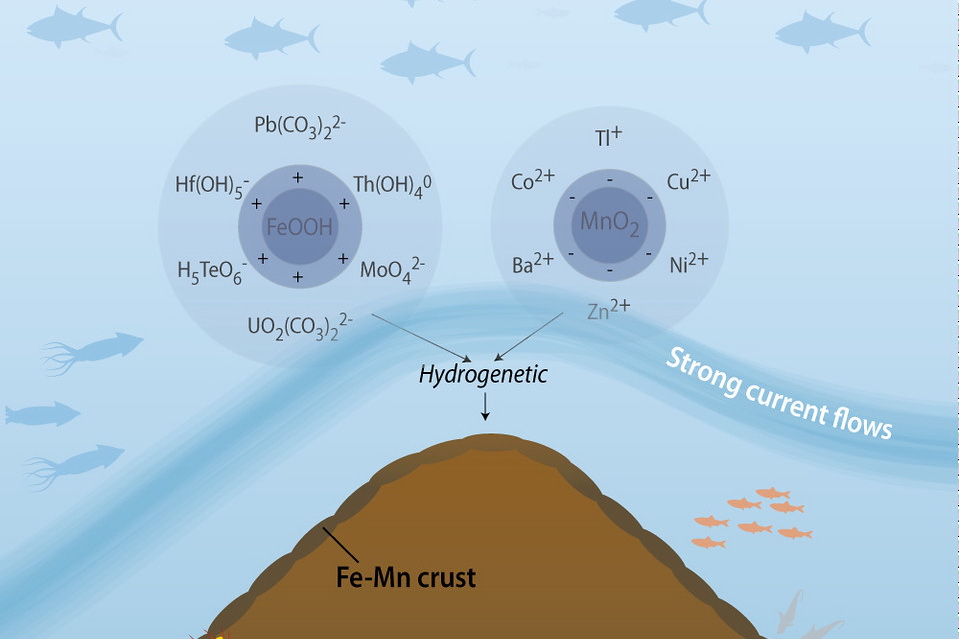Ferromanganese crusts (also referred to as Fe-Mn crusts, manganese crusts, cobalt-rich crusts, polymetallic crusts) are essentially two-dimensional deposits forming pavements on seamounts where rocks are exposed.
Illustration above: Ferromanganese (Fe-Mn) crusts are marine sedimentary mineral deposits, composed mostly of iron and manganese oxides. They precipitate very slowly from seawater, thereby recording the chemical signature of these source waters as they grow. Fe-Mn crusts grow extremely slowly on the flanks of seamounts and occur throughout the global ocean.
“They occur at water depths of about 800-7000 m on the flanks of extinct submarine volcanoes, ridges and plateaus, and some 100,000 are mapped throughout the global ocean from Antarctica to the North Pole. While their thickness rarely exceeds 25 cm, a conservative estimate is that 930 billion dry tonnes of ferromanganese crusts [potential ore] exist in the deep ocean,” says James Hein, retired from USGS and a world-renowned expert on this particular deep-sea deposit.
Critical materials in ferromanganese crusts include cobalt, manganese, molybdenum, nickel, vanadium, niobium, the 14 rare earth elements plus yttrium, and the very rare metals tellurium, scandium, and platinum.
James Hein will give a key note at NCS Exploration – Deep Sea Minerals (Bergen, Norway, October 19-21) entitled “Controls on the genesis and composition of ferromanganese crusts in the global ocean”. Metals in the Deep Sea.

Riches in the PCZ
The area considered to host ferromanganese crusts of greatest economic interest is the equatorial north Pacific Ocean that has been named the prime crust zone (PCZ).
“This PCZ features thick, metal-rich crusts, distributed over large regions. The dominant control on crust thickness is the age of the edifice on which the crusts grow. The longer time that a crust grows, the thicker it can get, although gravity-movement processes can destroy crusts, which will then begin to grow again,” says Hein who is now associated with Loke Marine Minerals.
Based on the tonnage estimate referred to above, ferromanganese crusts in PCZ alone may contain four times more cobalt, three and a half time more yttrium and nine times more tellurium than land-based reserves for those metals, as calculated by Hein (Encyclopaedia of Marine Geosciences, 2016).
“The concentrations of these elements vary locally, regionally, and globally and it is essential to know what controls the variation in grade, as a guide for exploration,” says Hein who will elaborate on this during the Bergen conference this fall.
Understanding the composition
Hein emphasises that variations in ferromanganese crusts chemical compositions are controlled by many factors. The most widespread factors include the concentration of dissolved phases of elements in ocean water; water depth; the oxygen content of the ocean water and the presence of an oxygen-minimum zone (OMZ) locally – which is related to primary productivity; proximity to continents or volcanic arcs; and proximity to hydrothermal systems (Hein et al., 2000; Mizell et al. 2020; Josso et al., 2021).
According to Hein, the Norwegian EEZ crusts are uniquely high in the very rare metal scandium.
«Seafloor pavements and encrusted rocks are known as ferromanganese crusts (also called cobalt-rich crusts). These crusts grow very slowly, at several millimetres per million years, and precipitate onto exposed rock surfaces throughout the global ocean—they do not form where sediment blankets the seafloor. In the oldest parts of the seafloor in the northwest Pacific Ocean, some crusts have been forming for over 70 million years and can be over 20 centimetres thick. Crusts act as a sponge of sorts, adsorbing metals and other elements from seawater over these long periods of time, and are especially enriched in cobalt, manganese, rare metals such as tellurium, precious metals such as platinum, and rare earth elements.” Adopted from USGS.
HALFDAN CARSTENS

